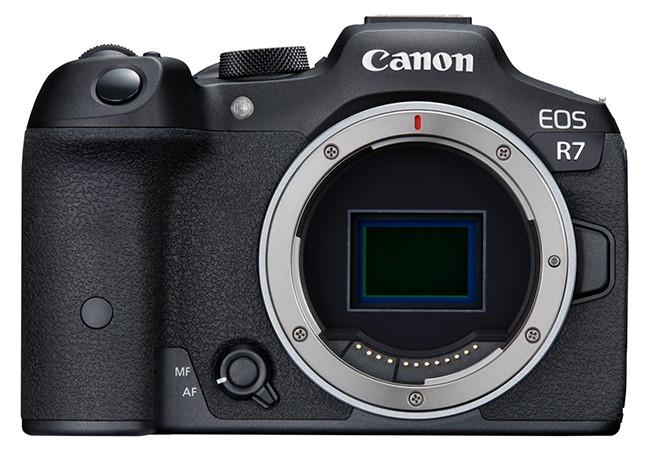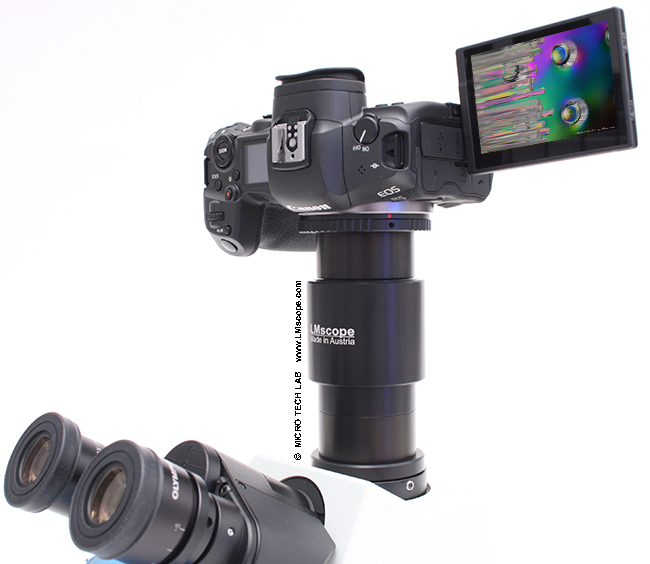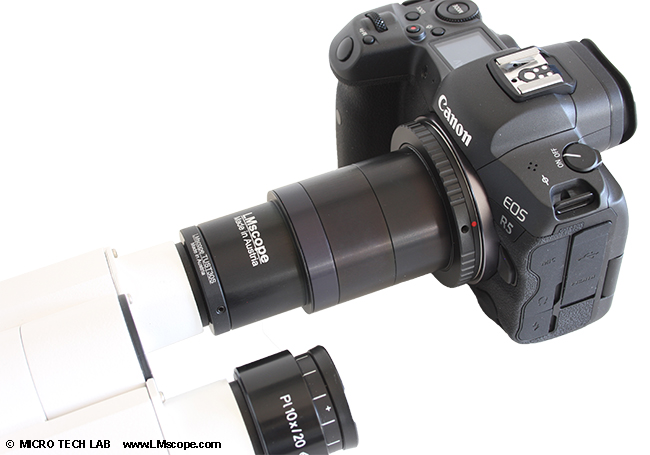

Taking a closer look at the Canon EOS R7: with LM digital adapter solutions, this mirrorless system camera is an ideal complement for every microscope
After plenty of speculation, Canon finally launched its first two first two APS-C EOS R-series cameras in the summer of 2022. We tested the R7, which offers sound quality in the mid-range segment, for its suitability for use in microscopy. The new flagship of Canon’s APS-C line currently retails at around EUR 1.500 (as of June 2022).

Key technical specifications:
- 32 MP APS-C (22.5 mm x 15.0 mm) CMOS imaging sensor
- High-speed continuous shooting at up to 30 fps with electronic shutter and up to 15 fps with mechanical shutter
- ISO range of 100 to 51,200
- Movie recording frame size (pixels) and frame rate: 3,840 x 2,160 (4K UHD) at up to 30p, 4K 60 fps with 7K oversampling
- Ability to record video past the usual 30-minute clip limit
- 3.0'' TFT LCD fully-articulating display
- Shutter speed from 1/16,000 to 30s
- Dual UHS-II SD memory card slots on the side of the camera
- Electronic sensor shift image stabilisation system
- USB 3.2 type C for data transfer, charging and continuous power
- HDMI micro out terminal (type D) to display the live image on an external monitor
- Built-in WiFi (wireless LAN), Bluetooth technology
- Weight: 612 g (body only)
- 4K and Full HD time lapse at 30 and 25 fps
- LP-E6NH battery pack
The EOS R7 is a great fit for use with a microscope. With our LM digital adapters, the camera can be attached to virtually any microscope. The most straightforward solution is to connect it directly to the dedicated phototube of the microscope (if available). The image below shows the camera attached to an Olympus microscope with a trinocular head. The high-quality adapter solution has specifically been developed to meet the most demanding requirements of professional imaging applications and gets the maximum image quality out of both microscope and camera.

For microscopes without a dedicated phototube, we offer an equally capable adapter solution for the eyepiece tube. To attach the camera, one eyepiece is removed and the camera, together with the adapter unit, is inserted into the tube where the eyepiece was.

Symbol photo: Canon EOS R on eyepiece tube 23.2mm or 30mm inner diameter
Until now, Canon APS-C system cameras were only available with the EOS M bayonet. With the R7 and the even smaller R10 (available for about EUR 1,000), the company has taken a step in a different direction. In terms of looks and size, the EOS R7 is very similar to the R6 – the R6 is just a little larger and heavier. The R10, on the other hand, is significantly smaller than both the R6 and the R7.
The R7 is part of Canon’s mirrorless range and is equipped with an ultra-fast APS-C image sensor with CMOS technology and a resolution of 32 megapixels. The R7 has a high pixel count for an APS-C camera, which makes it a great fit for low-power microscopes (magnification up to 30x) and macroscopes because the high resolving power of the camera allows capture of increased details under low magnification.
In addition to the mechanical shutter, the camera also has an electronic shutter for vibration-free (silent) shooting. The maximum shutter speed is 1/16,000 second in manual mode, which works great for capturing moving subjects without blurring them.
For continuous shooting, the R7 shares the identical ultra-high 30 (electronic shutter) and 15 fps (mechanical shutter) maximum frame rates of the current top-of-the-line, the Canon EOS R3. The same goes for the “little sister”, the R10, which, at 15 fps, also offers plenty of speed considering the lower price point. Comparable cameras like the Alpha 6600 “only” get a frame rate of 11 fps in highest-resolution mode.
The video specs of the EOS R7 are impressive: it captures 4K video and is even able to shoot oversampled 4K at up to 30p, using the full 7K area of the sensor. Oversampling means that the camera is capturing the clip in 7K mode, and then scales down the image data to 4K. In “normal” 4K mode, the R7 can shoot 4K video at up to 60 frames per second. The camera also lets you grab individual frames out of 4K video clips: the captured stills are about 8.3 MP (3840 x 2160) in size.
We also really like the fact that the 30-minute recording limit has been completely removed on the R7, so you can record for as long as the battery and/or memory lasts. Due to tariff regulations, the maximum recording time of many cameras is limited to just under 30 minutes. The R7 supports recording for up to 6 hours, but you need the right storage medium that is capable of handling the huge amounts of data recorded. The EOS R7 has twin UHS-II SD card slots for fast read and write speeds.
The R7 has a maximum ISO of 51,200, which is perfectly adequate even for low-light microscopy applications, such as fluorescence microscopy.
The fact that the R7 and R10 have both inherited the outstanding autofocus features of the R3 is not a significant aspect in microscopy, where only the camera body (without lenses) is used, but could appeal to many photographers who want to use the camera for additional applications beyond microscopy. However, there are only two compatible lenses available in the new RS system, which might be perceived negatively, but Canon’s EF-EOS R adapter, which is included with the R7, allows compatibility with existing EF lenses.
We generally recommend controlling the camera remotely from the computer with Canon’s EOS Utility software, which comes with the camera at no extra charge. The camera is connected to the computer with a USB cable, and the live image can be viewed conveniently from the computer screen. The magnifying function can be used to focus details more exactly, and the remote shutter release and the possibility to capture directly to the hard drive are also very useful features. In some cases, however, working with a computer is not possible, and this is where the camera’s fully-articulating display really comes in handy. The flexible design of the 3'' TFT LCD touchscreen (3:2 aspect ratio) gives you the freedom to adjust the screen in all directions to accommodate your working position. The touch screen makes it easy to control the camera. The screen brightness is adjustable to one of seven brightness levels.
Alternatively, Canon’s Camera Connect app can be used for remote control from a tablet or smartphone via WiFi.
In addition to transferring data, the USB port can also be used for charging the camera battery and as a continuous power source. It is a Superspeed USB (USB 3.2 Gen 2) equivalent USB-C port.
To display the live image on a large, 4K monitor, we recommend using the HDMI micro out terminal (type D).
Conclusion: The Canon EOS R7 is a great APS-C system camera that particularly stands out for its impressive speed. It is very well suited for microscopy – also because Canon’s EOS Utility software allows convenient control of the camera from the computer. With our flexible adapter solutions, which have built-in plan-achromatic precision optics, the R bayonet camera body can be attached to any type of microscope in just a few steps, delivering quick and impressive results.
New LM Digital Adapter for: Canon EOS R6 Mark II / Canon EOS R8 / Canon EOS R5 II / Canon EOS R5 / Canon EOS R6 / Canon EOS R / Canon EOS Ra (Astro) / Canon EOS RP / Canon EOS R7 / Canon EOS R10 / Canon EOS 1D X Mark III / Canon EOS 1D X Mark II / Canon EOS R100 / Canon EOS 1D X / Canon EOS 90D / Canon EOS 5D Mark IV / Canon EOS 6D Mark II / Canon EOS M6 Mark II / Canon EOS 250D / Canon EOS 850D / Rebel T8i / Canon EOS 6D / Canon EOS M200 / Canon EOS 5DS R ( without low-pass filter) / Canon EOS 80D / Canon EOS M50 Mark II / Canon EOS 5DS / Canon EOS M50 / Canon EOS 70D / Canon EOS 200D / Canon EOS 800D / Rebel T7i / Canon EOS 77D / Canon EOS 5D Mark III / Canon EOS 60D / Canon EOS 750D / Rebel T6i / Canon EOS 760D / Rebel T6s / Canon EOS 5D Mark II / Canon EOS 1D Mark IV / Canon EOS 7D Mark II / Canon EOS 600D / Rebel T3i / Canon EOS 650D / Rebel T4i / Canon EOS 700D / Rebel T5i / Canon EOS 2000D / Rebel T7 / Canon EOS 7D / Canon EOS 550D / Rebel T2i / Kiss X4 Digital / Canon EOS 1300D / EOS Rebel T6 / Canon EOS 4000D / Canon EOS 100D / Canon EOS 50D / Canon EOS 1200D / EOS Rebel T5 / EOS Kiss X70 / Canon EOS 1100D / Rebel T3 / Canon EOS 1D Mark III / Canon EOS 40D / Canon EOS 60Da for astrophotography / Canon EOS M100 / Canon EOS M6 / Canon EOS M5 / Canon EOS 1000D / Digital Rebel XS / Canon EOS 1Ds Mark III / Canon EOS M3 / Canon EOS 500D / Digital Rebel T1i / Canon EOS 450D / Digital Rebel XSi / Canon EOS M / Canon EOS 5D / Canon EOS 1D Mark II / Canon EOS 400D / Digital Rebel XTi / Canon EOS 30D / Canon EOS 20Da / Canon EOS 20D / Canon EOS 10D / Canon EOS 1D Mark II N /